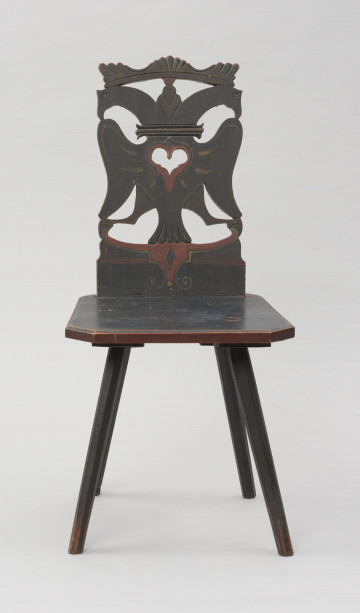
Bench
1. połowa XIX wieku
National Museum in Szczecin
Part of the collection: Pyrzycka folk culture
A sideboard, understood as a piece of furniture based on a cupboard with doors covering the shelves and a shallower part, the so-called settee with open shelves or glazed/covered doors, appeared as equipment of a country house relatively late, only in the 19th century. In Pomerania, Silesia, Warmia and Masuria and Greater Poland in the first, in the remaining areas of Poland in the second half of this century, and in some regions only in the twentieth century. In the wealthier strata of society, the sideboard was used from the 16th century (Italian credenza). It is still used today, mainly as furniture for storing dishes, cutlery and table linen. This sideboard is made of pine, the most commonly used wood in folk furniture making. The lower part - a cupboard-shaped base is closed with a panelled door. It also has two shelves, the higher of which is narrower. The upper uncovered part of the sideboard has two shelves suitable for placing plates, two rails with cut-outs for cutlery, and at most seven hooks for hanging cups. Like the majority of Pyrzyce furniture, the sideboard is painted navy blue and decorated with red, green (two shades) and white floral motifs. The door is decorated with a vase with a bouquet of flat-headed flowers bearing the date of 1850. The slats of the shelves in the upper part of the sideboard are decorated with geometrical motifs with different patterns. On the sidewalls, tulips, the favourite flowers of the inhabitants of the Pyrzyce region originating from the Netherlands, are painted.
Iwona Karwowska
Author / creator
Dimensions
cały obiekt: height: 182 cm, width: 86 cm
Object type
sideboard
Creation time / dating
Creation / finding place
Identification number
Location / status

1. połowa XIX wieku
National Museum in Szczecin

1176 — 1225
National Museum in Szczecin

przełom XIX i XX wieku
National Museum in Szczecin
DISCOVER this TOPIC
National Museum in Lublin
DISCOVER this PATH
Educational path